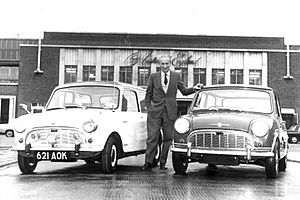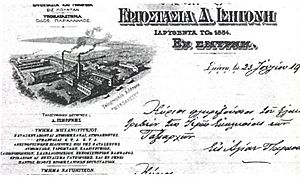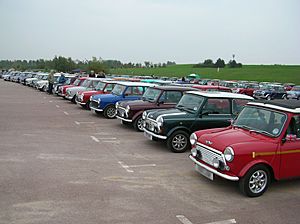Alec Issigonis facts for kids
Quick facts for kids
Sir Alec Issigonis
|
|
|---|---|
 |
|
| Born |
Alexander Arnold Constantine Issigonis
18 November 1906 |
| Died | 2 October 1988 (aged 81) Edgbaston, Birmingham, England
|
| Nationality | British |
| Occupation | Automotive designer |
Sir Alexander Arnold Constantine Issigonis (born November 18, 1906 – died October 2, 1988) was a brilliant British car designer. He is most famous for creating the Mini car. The Mini was launched in 1959 by the British Motor Corporation. In 1999, it was voted the second most important car of the 20th century.
Contents
Early Life and Education
Alec Issigonis was born on November 18, 1906, in Smyrna, a city in the Ottoman Empire. He was the only child of Constantine Issigonis and Hulda Prokopp. His grandfather, Demosthenis, had moved to Smyrna from the Greek island of Paros. Alec's father, Constantine, was a very successful and rich engineer who built ships.
Alec and his parents were British citizens. In September 1922, the British Navy helped them escape to Malta. This happened just before the Great Fire of Smyrna and the Turkish army took over Smyrna. His father passed away soon after. In 1923, Alec and his mother moved to the United Kingdom.
Issigonis studied engineering at Battersea Polytechnic in London. He found mathematics very difficult and failed his exams three times. He later said math was "the most uncreative subject you can study." Despite this, he finished his university education through the University of London External Programme.
Designing Cars
Issigonis started his career in the car industry as an engineer and designer. He worked for companies like Humber. He also enjoyed racing cars in the 1930s and 1940s. He often raced a special Austin 7 car that he had modified himself.
In 1936, he joined Morris Motors Limited. There, he worked on a new front suspension system for the Morris 10 car. World War II stopped this design from being made. However, it was later used in the MG Y-type car.
During the war, he worked on many projects for Morris. Towards the end of the war, he began designing a new car called the Mosquito. This car later became the famous Morris Minor. The Morris Minor was produced from 1948 until 1971. Issigonis was very proud of the Morris Minor. He felt it offered many good features at a price that working-class families could afford.
In 1952, Morris and Austin car companies merged to form the British Motor Corporation (BMC). Issigonis moved to Alvis Cars. There, he designed a fancy car with an all-aluminium V-8 engine. He also experimented with new suspension systems. This car was never made because it was too expensive for Alvis.
Creating the Mini
At the end of 1955, Sir Leonard Lord, the chairman of BMC, asked Issigonis to return. Lord wanted him to design a new family of three cars. These cars had secret code names:
- XC/9001 for a large, comfortable car.
- XC/9002 for a medium-sized family car.
- XC/9003 for a small city car.
In 1956, Issigonis focused on the two larger cars. But at the end of 1956, there was a fuel shortage because of the Suez Crisis. Lord then told Issigonis to quickly get the small car, XC/9003, ready for production.
By early 1957, test versions of the car were running. In August 1959, the car was launched as the Morris Mini Minor and the Austin Seven. Soon, it became known simply as the Mini. The Mini became the best-selling British car ever, with 5.3 million cars made.
The Mini had a revolutionary design:
- It had front-wheel drive.
- The engine was placed sideways (transverse engine).
- It had small 10-inch wheels.
- It was incredibly space-efficient, meaning it had a lot of room inside for its small size.
This clever design has inspired almost all small front-wheel drive cars made since the 1960s. The Mini was even still being made in the year 2000!
Later Designs and Retirement
In 1961, as the Mini became very popular, Issigonis was promoted to Technical Director at BMC. He continued to work on his original car projects.
- XC/9002 became the Morris 1100, launched in 1962.
- XC/9001 became the Austin 1800, launched in 1964. Issigonis was most proud of the Austin 1800, even though it wasn't as successful as his other designs.
- His next car was the Austin Maxi.
In 1969, BMC merged with other companies to form British Leyland. The new chairman, Lord Stokes, moved Issigonis to a special role called "Special Developments Director."
Issigonis was sometimes called "the Greek god" by people he worked with. He officially retired from the car industry in 1971. However, he kept working almost until his death in 1988 at his home in Edgbaston, Birmingham.
Legacy and Honours
On October 15, 2006, a special event was held at the British Motor Museum in Gaydon, England. It celebrated 100 years since Issigonis's birth.
There is a road named "Alec Issigonis Way" in the Oxford Business Park. This park is on the old site of the Morris Motors factory in Cowley, Oxfordshire.
Issigonis received many important awards:
- He was made a Commander of the Order of the British Empire in 1964.
- He was knighted by Elizabeth II in 1969, becoming "Sir" Alec Issigonis.
- In 1964, he was named a Royal Designer for Industry.
- In 1967, he became a Fellow of the Royal Society, which is a very high honour for scientists.
Some of His Cars
- 1964 BMC ADO17 (Austin 1800)
- 1969 Austin Maxi
See Also
 In Spanish: Alec Issigonis para niños
In Spanish: Alec Issigonis para niños
Images for kids









